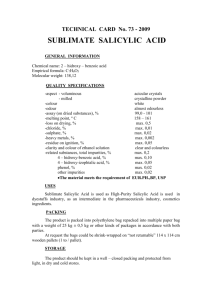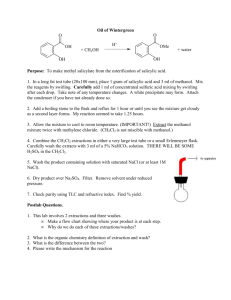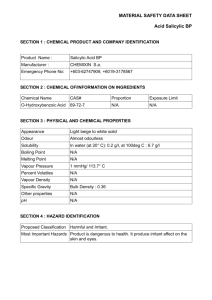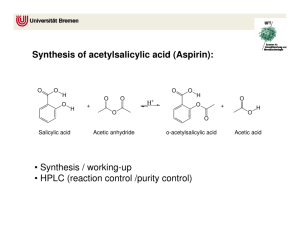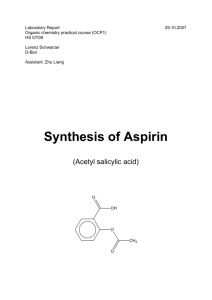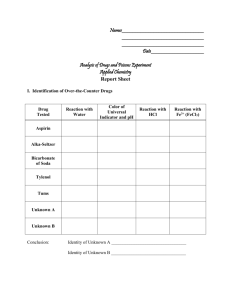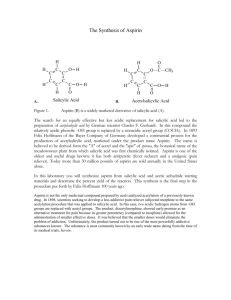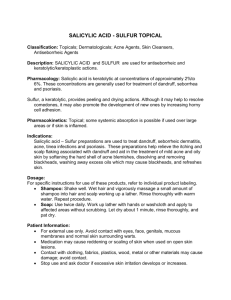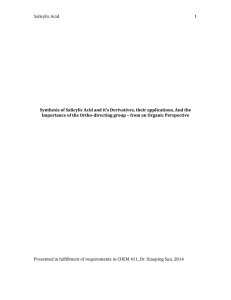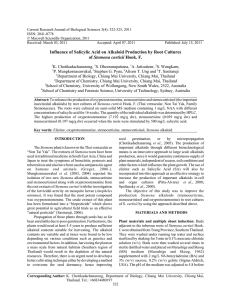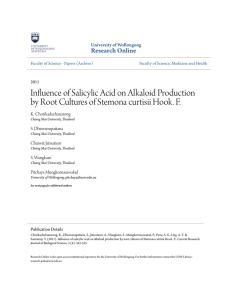Esterification of Salicylic Acid: The synthesis of cool smelling
advertisement
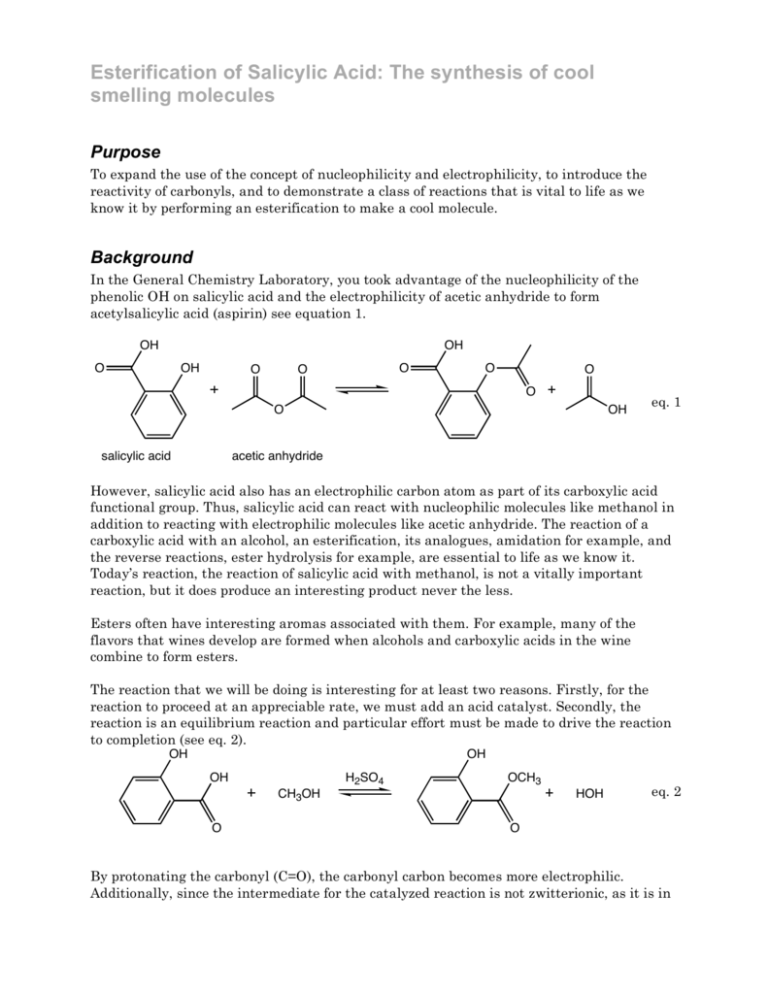
Esterification of Salicylic Acid: The synthesis of cool smelling molecules Purpose To expand the use of the concept of nucleophilicity and electrophilicity, to introduce the reactivity of carbonyls, and to demonstrate a class of reactions that is vital to life as we know it by performing an esterification to make a cool molecule. Background In the General Chemistry Laboratory, you took advantage of the nucleophilicity of the phenolic OH on salicylic acid and the electrophilicity of acetic anhydride to form acetylsalicylic acid (aspirin) see equation 1. OH OH O OH O O O O O O O salicylic acid OH eq. 1 acetic anhydride However, salicylic acid also has an electrophilic carbon atom as part of its carboxylic acid functional group. Thus, salicylic acid can react with nucleophilic molecules like methanol in addition to reacting with electrophilic molecules like acetic anhydride. The reaction of a carboxylic acid with an alcohol, an esterification, its analogues, amidation for example, and the reverse reactions, ester hydrolysis for example, are essential to life as we know it. Today’s reaction, the reaction of salicylic acid with methanol, is not a vitally important reaction, but it does produce an interesting product never the less. Esters often have interesting aromas associated with them. For example, many of the flavors that wines develop are formed when alcohols and carboxylic acids in the wine combine to form esters. The reaction that we will be doing is interesting for at least two reasons. Firstly, for the reaction to proceed at an appreciable rate, we must add an acid catalyst. Secondly, the reaction is an equilibrium reaction and particular effort must be made to drive the reaction to completion (see eq. 2). OH OH OH H2SO4 OCH3 CH3OH O HOH eq. 2 O By protonating the carbonyl (C=O), the carbonyl carbon becomes more electrophilic. Additionally, since the intermediate for the catalyzed reaction is not zwitterionic, as it is in the uncatalyzed reaction (see Scheme 1), the transition state that leads to the intermediate is lower in energy for the catalyzed reaction as compared to the uncatalyzed reaction. The acid catalyst also lowers the activation energy for the elimination of water from the intermediate. While the addition of the acid gets the reaction going, it cannot drive the equilibrium towards the products. Instead, this reaction will be driven to completion by the addition of excess methanol. Alternative methods for driving the reaction to completion include the removal of water from the reaction. Scheme 1 OH OH OH OH O HOCH3 OH OH O OCH3 OCH3 H reactant and intermediate for the uncatalyzed reaction OH HOCH3 OH HO OCH3 H reactant and intermediate for the catalyzed reaction Procedure1 Formation of methylsalicylate 1. Place 0.65 g of salicylic acid, 2.0 mL methanol, and a spin vane in a 5-mL conical vial. 2. Stir the mixture until the salicylic acid dissolves. 3. Place the conical vial in an aluminum block on a stirring hotplate, and, while stirring, slowly, and in small portions, add 0.75 mL of concentrated sulfuric acid to the salicylic acid–methanol solution. 3. Attach the 5-mL conical vial to a water-cooled condenser, cap the condenser with a drying tube that has been loosely packed with CaCl2. 4. Gently boil the solution for 75 minutes (maintain the temperature of the aluminum block at approximately 80 °C). Isolation of methylsalicylate 5. After the solution cools to room temperature, add 1 mL of CH2Cl2, to the reaction mixture 6. Shake the resulting suspension (with venting) 7. Allow the layers to separate, and transfer the organic layer, which contains your product, to another container. 8. Repeat steps 5, 6 and 7 twice more. 9. Add 1 mL of an aqueous 5% sodium bicarbonate solution to the combined CH2Cl2 extracts 10. Mix the solutions together, allow the solvents to separate, and transfer the organic layer to a clean, dry vial. 11. Dry the CH2Cl2 solution with anhydrous sodium sulfate. 12. Evaporate the CH2Cl2 using a warm water bath and a gentle stream of compressed air. Determine the mass of your product, and obtain an IR spectrum your product, methylsalicylate. 13. Obtain a copy of an IR spectrum of salicylic acid. Note the smell of your product. Report Write an experimental report describing the synthesis of methylsalicylate. Attach the IR spectra of salicylic acid and methylsalicylate. Compare the OH region of the IR spectra and explain why the OH regions look different (keep your explanation short and simple). Adapted from Introduction to Organic Laboratory Techniques: A Microscale Approach. Pavia, Lampman, Kriz, and Engel. (1999) Saunders College Publishing. 1
